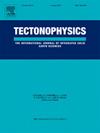Are strain rate lows proxies of low-potential of strong earthquakes? A case study in Western China
IF 2.7
3区 地球科学
Q2 GEOCHEMISTRY & GEOPHYSICS
引用次数: 0
Abstract
Strain accumulation is closely related to the occurrence of strong earthquakes. To investigate the pre-seismic deformation status of strong earthquakes, the correlation between the GNSS (Global Navigation Satellite System) strain rates and earthquakes subsequent to the GNSS observation period in Western China was studied. The primary results show that a large part of MW ≥ 6.0 earthquakes occurred in the medium and low value regions (MLVR) of the second invariant of strain rate (SR). Meanwhile, about 81 % of strike-slip earthquakes occurred in the MLVR of the maximum shear strain rate, and the ratios are 72 % and 100.0 % for the reverse-faulting and normal-faulting earthquakes in the MLVR of principal compressive and tensile strain rates, respectively. The sustained slow fault slip rates, complex faults in different stages of inter-seismic period, and historical earthquakes, may possibly cause the typical strain rate patterns for the pre-seismic stage. Therefore, Mw ≥ 6.0 earthquakes possibly occur in MLVR of strain rates, and low strain rate is not an indicative of low-potential of strong earthquakes.
低应变率是强地震低势能的代用指标吗?中国西部案例研究
应变累积与强震的发生密切相关。为研究强震震前变形状况,研究了中国西部地区全球导航卫星系统(GNSS)应变率与GNSS观测期后地震的相关性。主要结果表明,大部分 MW≥6.0 地震发生在应变率(SR)第二不变量的中低值区(MLVR)。同时,约 81% 的走向滑动地震发生在最大剪切应变率的 MLVR 中,反褶和正褶地震在主压应变率和主拉应变率 MLVR 中的比例分别为 72% 和 100.0%。持续缓慢的断层滑动速率、处于震间不同阶段的复杂断层以及历史地震,可能是造成震前阶段典型应变率模式的原因。因此,Mw ≥ 6.0 地震可能发生在应变率的 MLVR 中,而低应变率并不代表低强震潜力。
本文章由计算机程序翻译,如有差异,请以英文原文为准。
求助全文
约1分钟内获得全文
求助全文
来源期刊

Tectonophysics
地学-地球化学与地球物理
CiteScore
4.90
自引率
6.90%
发文量
300
审稿时长
6 months
期刊介绍:
The prime focus of Tectonophysics will be high-impact original research and reviews in the fields of kinematics, structure, composition, and dynamics of the solid arth at all scales. Tectonophysics particularly encourages submission of papers based on the integration of a multitude of geophysical, geological, geochemical, geodynamic, and geotectonic methods
 求助内容:
求助内容: 应助结果提醒方式:
应助结果提醒方式:


